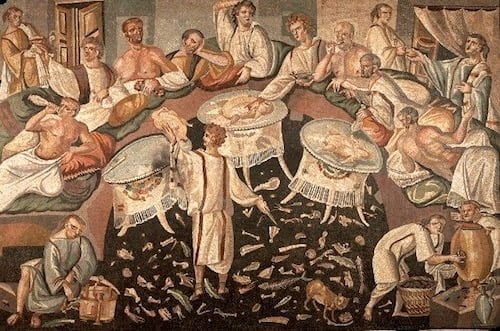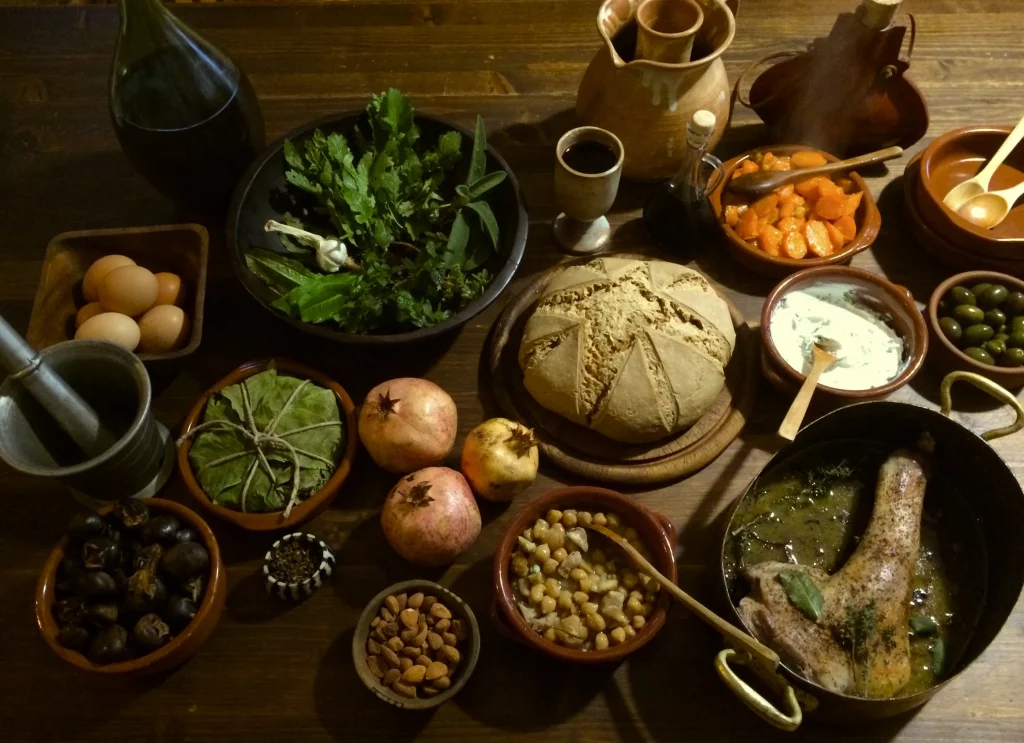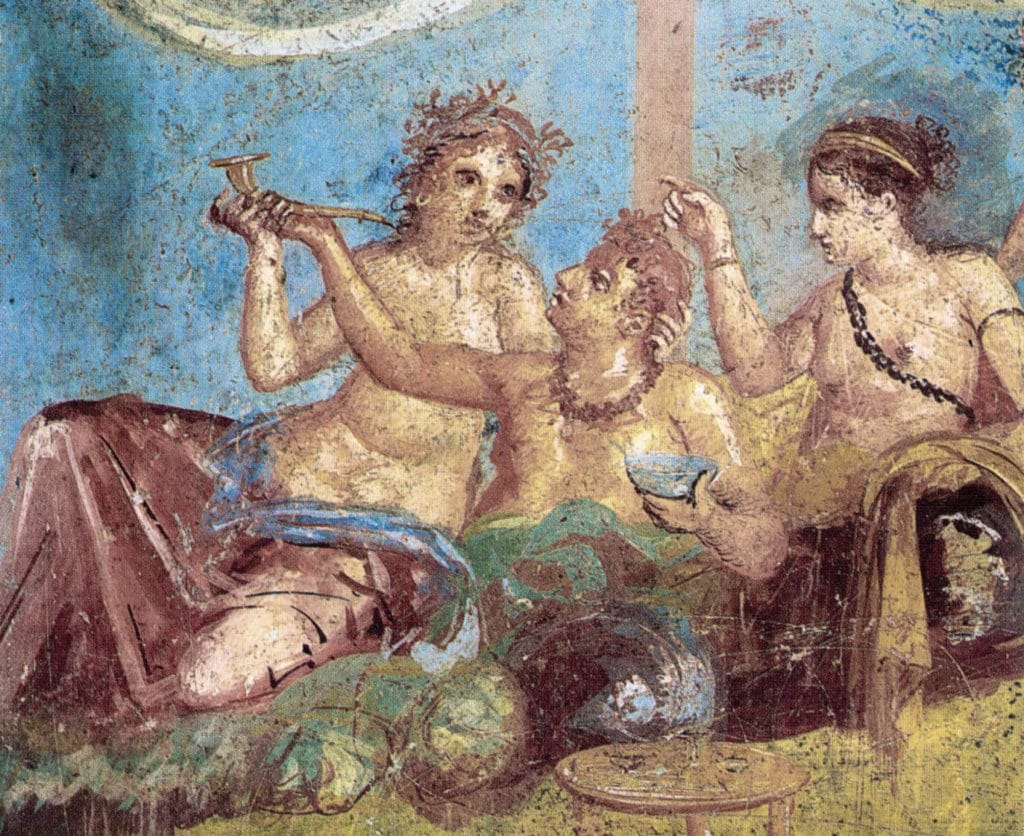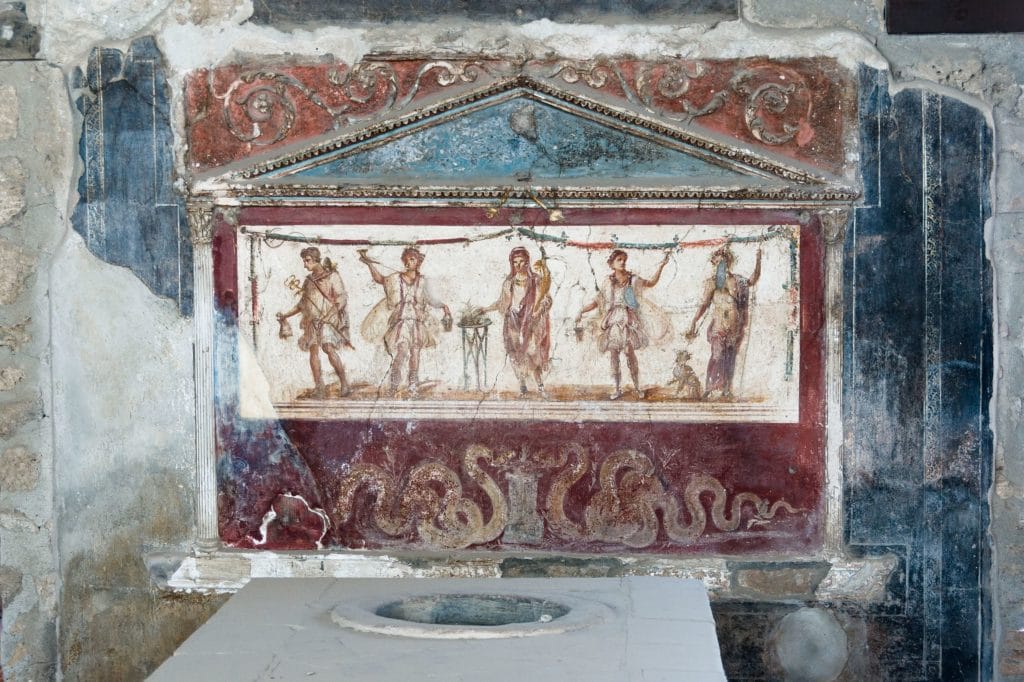Last updated on July 22nd, 2022 at 05:18 pm
In Monty Python The Life of Brian, a film set in Roman Judaea around the time of Christ, there is a scene where the film’s main protagonist, a reluctant messiah called Brian, is selling snacks at the local amphitheater.
His goods were unusual, to say the least, and included larks’ tongues, wrens’ livers, chaffinch brains, and jaguars’ earlobes. The scene is interesting, not because the Romans ate jaguar earlobes, but because it highlights the fact that there were very significant differences between the Roman diet and that of modern western societies. So here we look at what people ate in ancient Rome.
Roman Meals
Firstly, the Romans ate at times different to some parts of the world today but similar to others, depending on where one is.
There were a number of main meals. Two of these were equivalent to breakfast. Ientacalum was a quick snack when an individual first rose, but the main breakfast, which was more like brunch, was prandium, consumed before midday.

The main meal of the day, the equivalent of dinner, was cena, which was in the early afternoon after they finished the day’s work. Cena could last for several hours and was a leisurely affair characteristic of the Mediterranean.
In addition, some people availed of vesperna, which was a light supper in the evenings or at nightfall.
Roman Staple Foods
Despite depictions often made of Roman gluttony and excess at banquets and feasts, the Roman diet was somewhat conservative. Cena for the majority of people, might consist of a kind of porridge or stew made from emmer, a species of hulled wheat, salt, and pork fat.
One could add olive oil and other items such as vegetables, meat, or fish. Wealthier Romans might also consume this with eggs, cheese, and other items such as honey to add flavor.

As it was known, this porridge or puls would be accompanied by a lot of bread for ordinary Romans. Indeed bread was the staple food of the ancient Romans, with huge shipments of grain arriving in Rome throughout the year from North Africa or Sicily, the empire’s breadbasket.
This wheat was then distributed as a free dole to all Roman citizens to make their bread. Thus, the bread dole was the Roman version of social welfare.
Beyond cena the morning and evening meals would have consisted more of light soups, accompanied by vegetables and fruit. Thus the Roman diet for many, as in the modern world, was quite routine.
Wheat and other cereals comprised about 50% of all calories consumed in the Roman Empire. Vegetables and starchy roots such as beans and peas made up nearly 40%, which means that the Romans were considerably healthier than modern Americans and Europeans.
More fish and seafood were consumed than meat, which was only available in large amounts to the wealthy. All of this, however, is not to say that there were not some substantial differences between Roman diets and our own.
Based on the references to certain food types in Roman source material, historians can determine, for instance, that the Romans were obsessed with flavoring food with black pepper, honey, and coriander.
In terms of fruit, they consumed far more peaches than apples, while pomegranate and mint were far more ubiquitous in a Roman kitchen than in a modern American or European one.
Finally, some foods were avidly consumed by the Romans, which are unknown to us today. One of these is silphium, a product that historians believe may have been a type of fennel native to Libya but is now extinct. Maybe it was because the Romans consumed so much of it!
Roman Luxury Foods
Perhaps where the Romans differed most in their dietary habits from modern people was in terms of the luxury foods they consumed and here is where Monty Python’s Life of Brian wasn’t too far away from reality at all.
Wealthier Romans enjoyed many of the things we consider to be delicacies such as oysters, pheasant and caviar, though beef was surprisingly unpopular.
As the empire became richer and more decadent these were often consumed in elaborate banquets which lasted hours. But there were some genuinely strange dishes on offer here too.

A good example is flamingo’s tongue, which was considered a real delicacy. Dormice were also consumed by the rich, as was jellyfish. And other animals which we are simply trying to prevent from going extinct today were actually eaten 2,000 years ago, such as giraffe and other African animals.
That said there were always things which are surprisingly modern. For example, the Romans ate a form of pizza, though it was another 1,500 years before Europe would have access to a tomato to put on it, and both sorbet and ice cream were made and consumed in Roman times.
Roman Gourmands
Classical historians who turn to study what the Romans ate and how they prepared it are fortunate in that many Romans were serious enough about their cooking that they wrote cookbooks.
Marcus Gavius Apicius, a Roman gourmand of the first century AD, is the most significant of these whose works have survived to the present day. Apicius composed a book entitled De Re Culinaria, meaning On the Subject of Cooking.
This provided details on how to run a successful kitchen, along with a wide range of recipes and a discussion of Roman food. De Re Culinaria contains numerous recipes for dishes such as stews, salads, and ragouts, which have been replicated ever since and which have continued to influence Italian cuisine down to the present day.
Roman Fast Food
Of course, no major civilization is complete without its own version of fast food. In Rome and the other cities and towns of the empire, the places where this could be found were known as thermopolium, literally meaning ‘a place where something hot is sold’.
These were small establishments, effectively consisting of a small room around which a marble or wooden counter ran. Along this counter, earthenware pots called dolia were set at regular intervals.
These were filled with food that was prepared either behind the counter or in an adjoining kitchen. Effectively Romans could just walk up, take a seat at the counter, and minutes later, food would be put into the dolia for them.

The fare consisted of a wide range of skewered meat, sausages, game, fish, cheese, vegetables, fruit, bread, eggs, and olives, accompanied by wine.
These thermopolium would have been everywhere in Rome. In Pompeii alone, the city which was covered by volcanic ash from Mount Vesuvius in 79 AD, there are the remains of 89 different thermopolium, and Pompeii was only an average-sized town.
Thus, these establishments were absolutely central to Roman food habits. Think of them as a Roman version of Burger King, just not one that served chaffinch brains!
What Ancient Romans Ate
Although some of the food of ancient Rome would be considered quite strange by today’s standards, it’s surprising how much modern cuisine has in common. So, the next time you are feeling adventurous, why not try out some of the recipes from this period? You may be surprised at how tasty they are!

